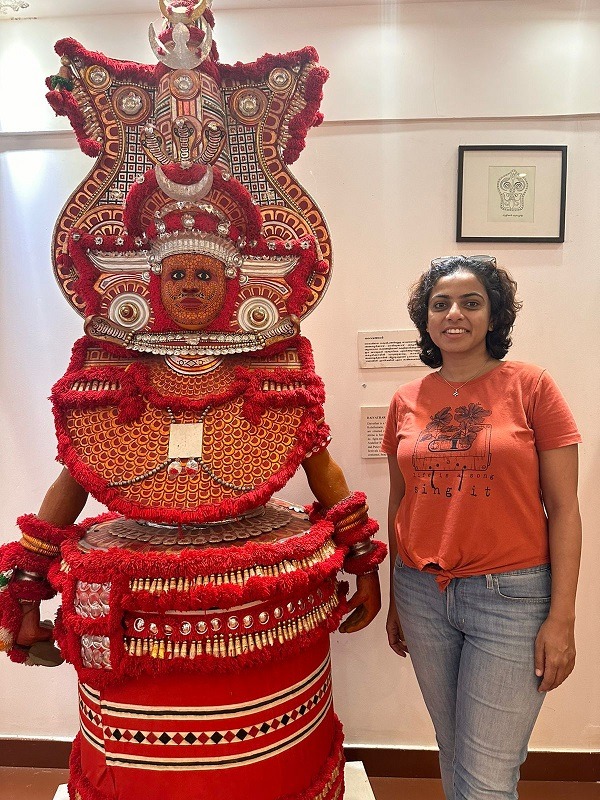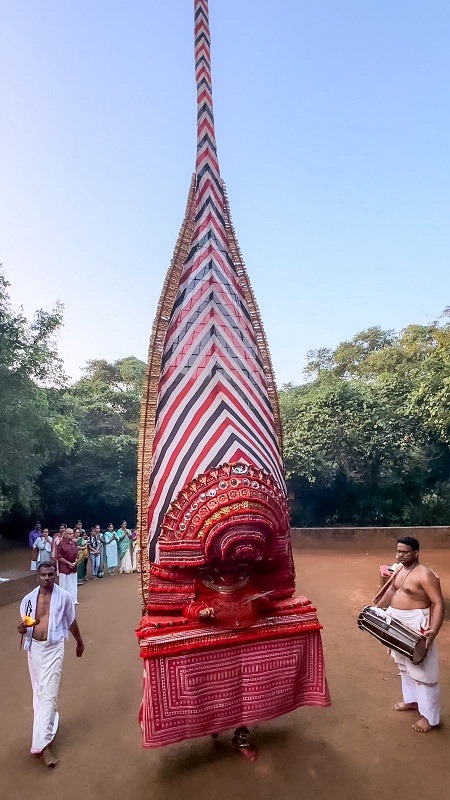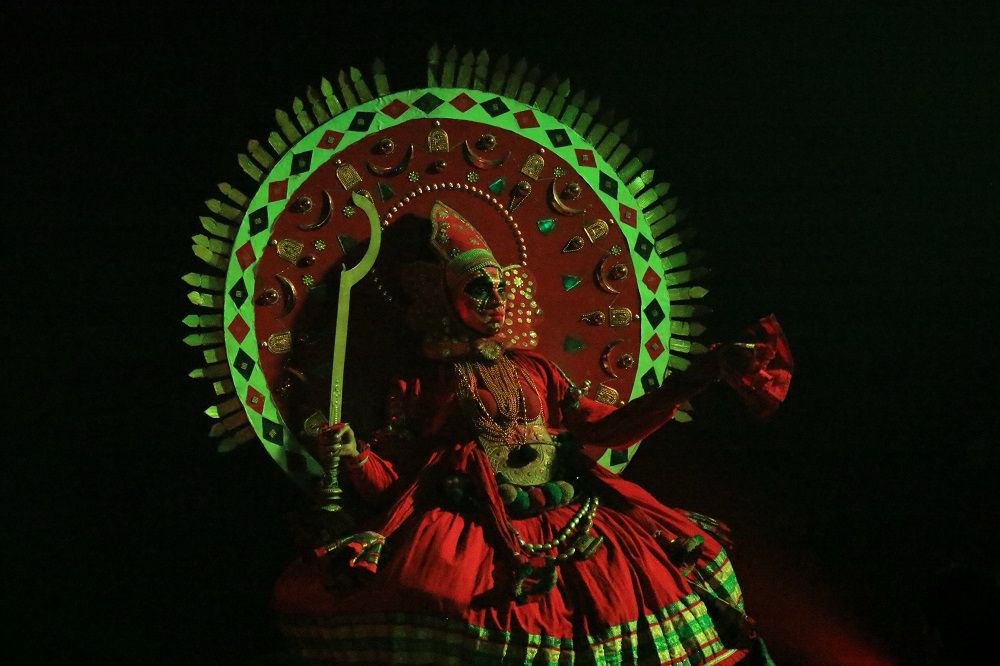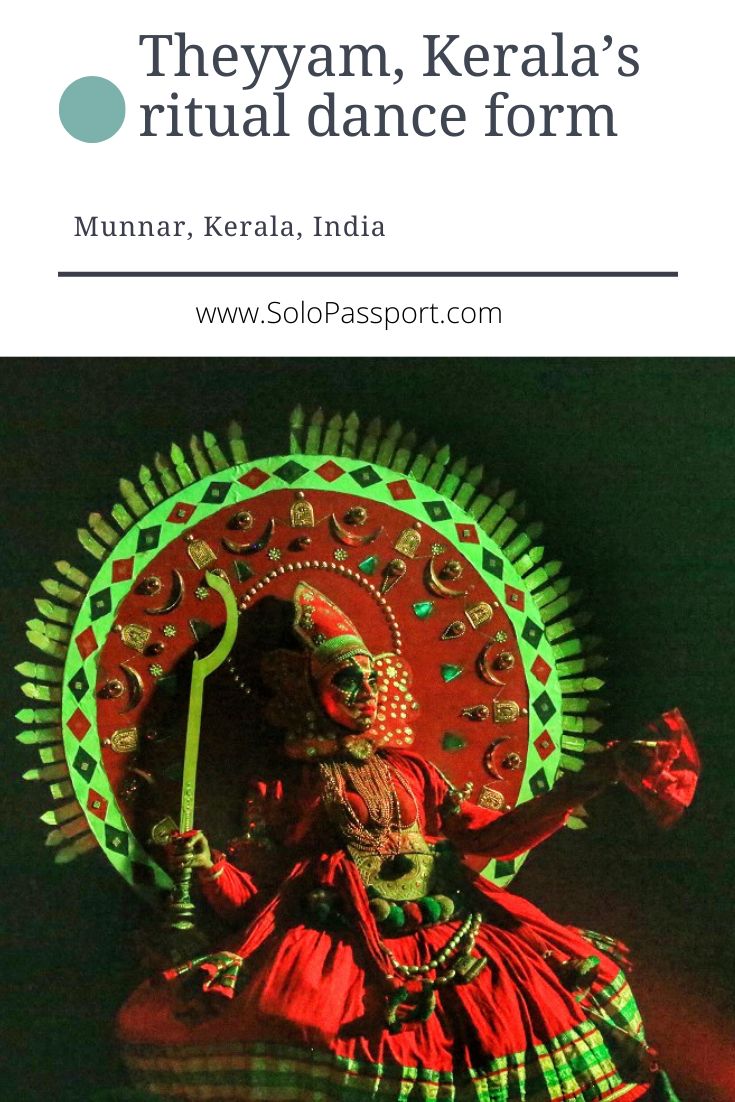Colours, Myths, and Mystique: The Spellbinding World of Theyyam in Kerala (2024)
When we think of a dance form of Kerala, we always think of Kathakali and not Theyyam. But did you know that Theyyam has a long history in Kerala and is one of the ritual dance forms? It is as vibrant as Kathakali and has many stories to tell and is an integral part of Kerala’s customs and traditions.
Consisting of thousand year old traditions that have been passed on through generations, Theyyam is a spiritual experience you need to have when you are in Kerala. And the dancers perform with beautiful costumes and folk music.
I have been blessed to have witnessed this amazing dance ritual twice, once as a performance part of the Pre-Mart tour 2022, in collaboration with Kerala Travel Mart and Kerala Tourism, and two as part of a family custom in the midst of a forest. Not just witnessing this performance, I have had an opportunity to get a blessing from Theyyam.
This article may contain affiliate links, meaning if you decide to purchase via my links, I may earn a commission at no additional cost to you. For complete information, please see our affiliate disclaimer here.
Page Contents
PIN for later reference
About Theyyam
Also spelt as Teyyam, Theyam and Theyyattam, Theyyam is Kerala’s ritual dance form that consists of thousands of years of traditions, customs and rituals. Meaning God in Malayalam language, the locals of Kerala consider Theyyam as a channel to god and seek blessings from Theyyam.

History of Theyyam
Theyyam has been referenced in many old literature and historical documents, such as Keralolpathi and Sangam. It is believed that Parashurama, the sixth incarnation of Lord Vishnu, granted the land of Kerala some of the festivals such as Kaliyattam, Puravela, Daivattam and Theyyattam. Theyyam originated from Kaliyattam, which lasts for 3 to 11 days, and the indigenous tribal people were given the responsibility of performing the Theyyam dance form.
Also read | Yakshagana, Karnataka’s dance form.
The Sangam literature talks about Velan, one of the Theyyam dancers, who was employed by the mothers of love-rejected girls to drive out the malignant spirits from their daughters. There are also evidences that prove that Theyyam may have originated during the earliest period of Neolithic, Chalcolithic settlement and expression.
Types of Theyyam
In Kerala, there are more than 400 types of Theyyam. All of the types are performed by males except the Devakoothu Theyyam, which is performed by women. The Devakoothu Theyyam is performed only at Thekkumbad Kulom temple, which is located in the Kannur region of Kerala.

Out of 400 Theyyams, among 112 are the most famous ones and are performed even today at various shrines and festivals. Some of the famous types are:
- Vishnumoorthi – The most popular is the Vishnumoorthi Theyyam, and it narrates the story of Hiranyakashipu’s death by Lord Narasimha, who was one of the Lord Vishnu’s avatars.
- Muthappan – The Muthappan Theyyam consists of two divine figures, Thiruvappana Muttapan (Vishnu) and Vellatom Muttapan (Shiva).
- Padikutti Amma – The Padikutti Amma Theyyam narrates the story of Padikutti Amma, the mother of Muthappan.
- Gulikan – The Gulikan Theyyam represents Yama, the Hindu God for death.
- Padamadakki Bhagavathy – The Padamadakki Bhagavathy Theyyam tells the story of the goddess who helped Nileswarr Raja against an invading army from Karnataka. Upon seeing Padamadakki Bhagavathy, the attacking army fainted and hence the war was averted.
- Kathivanur Veeran – The Kathivanur Veeran Theyyam narrates the story of a warrior Mandhappan.
- Manakkott Amma – The Manakkott Amma Theyyam narrates the story of Manakkott, who was killed by the head of the family as she broke one of the caste rules. At that time, she was pregnant, and her murder caused a lot of problems for the family, later destroying it completely. Manakkott later emerged as a goddess.
- Kuttichattan – The Kuttichattan Theyyam is associated with a deity from the Brahmin family Kalakattu illam. There are many myths and stories associated with Kuttichattan.
- Chamundi – The Chamundi Theyyam narrates the stories of Chamundi slaying daemons. Chamundi is the form of Goddess Kali or Durga. The Chamundi form representing Kali is immersed in the colour of blood and is also known as Rakta Chamundi or Rakteshwari.
Tradition of Theyyam
Part of the religion and region of Kerala’s culture and traditions, the Theyyam in a natural setting (not a stage) can be seen in Kannur and Kasargod districts. The tradition has been living among the locals for the past 1500 years and embraces all kinds of communities within the Hindu religion.
Theyyam is usually sponsored by family so they could seek blessings from Theyyam. The families worship one or more Theyyams and have the performance of Theyyam in natural settings such as forests, sacred places or corners of the house. In such a setting, Theyyam dances and takes over a demi-God and listens to the problems/prayers of the family members. After this, Theyyam gives solutions and speaks encouraging words to provide morale to the family.
These experiences are special, and you will need to be invited by the family sponsoring Theyyam. I had this special experience in Kannur where I not only saw the demi-God Neeliyar Kottam but also got her blessings. Even though she spoke to me in the Malayalam language, the translation of those words was, “I know that your soul respects me, and that’s why you are here. I can see in your soul. Keep your spirit high and keep going“. It has been one of the most spectacular and nail-biting experiences of my life.


Performance of Theyyam
The performance of Theyyam consists of dance, cultural drama and expression, vocal recitations, peculiar makeup, costumes and music, and is generally performed in front of a village shrine. These performances last for 12 to 24 hours with intervals.
The dancers perform the ancient tribal beliefs worshipping the heroes and spirits of the ancestors. Dances are accompanied by folk music played using folk musical instruments. Traditional dance performers wear exotic dresses with face paintings and perform ritualistic dances in an open theatre.

Theyyam is usually performed in North Kerala, especially in Kannur and Kasargod districts. But some of the traditional and cultural performances in the other parts of Kerala also include Theyyam performances and I was fortunate to see a live performance in Munnar.
Theyyam Festival
The best and the only time to see Theyyam in Kerala between the months of October and May every year. There is also a festival that is held between these months. There are no Theyyam held during the monsoon season (June to September).
Kerala Folklore Academy in Kannur
Established by Kerala government in 1995, the Kerala Folklore Academy in Kannur is a great place to see and learn about Kerala’s rich folk traditions, especially Theyyam. There are rooms within the museum dedicated to types of Theyyam, including the costumes, face masks, and history.
- The museum is open every day between 10 AM and 4:30 PM. On Sundays, the museum is open only till 4 PM.
- There is an entrance fee of Rupees 30 per person and an additional charge of Rupees 200 per person.

Where to see Theyyam?
Even though Theyyam is mainly part of the Kolathu Nadu region, which includes Kannur and Kasaragod, there are still many places across Kerala where you can see the performances. These days, the performances are held in Wayanad and Kozhikode and also extend to the Kodagu and Tulu Nadu regions of Karnataka.
Also Read: Sree Padmanabhaswamy Temple, World’s Richest Temple
Performances in Kannur
Theyyam’s regular performances in Kannur happen at Parassini Madappura Sree Muthappan temple. Usually, the performances happen twice, first in the morning during the sunrise and second in the evening during the sunset.
There are charges to see the performances that you can get at the entrance of the temple. Also, it is best to check with your hotel staff prior to going for the performance as there are times where the schedule changes and it can be for many reasons like family influence, or the weather.
How to Get to Kannur?
Renowned for its Theyyam rituals, Kannur is a district located in the northern part of the Indian state of Kerala.
- By Air – Kannur has its own international and domestic airport. The airport is situated around 27 kilometres from the city of Kannur, and the journey takes 45 minutes by road. You can take a taxi to the airport to be dropped off in the city.
- By Public Transport – Kannur also has a railway station of its own that is connected to major cities and towns around. The train station is located in the city. Check IRCTC for up-to-date information on trains.
- By Road – Kannur is around 90 kilometres from Kozhikode and by road, the journey takes up to 3 hours. The route is along the coast and is very beautiful.
Performances in Munnar
The best place to see Theyyam performance in Munnar is at Punarjani traditional village, around 7 kilometres from the town. There are daily shows at 5 PM where visitors can enjoy the fusion of Kathakali, Bharatanatyam and Theyyam. The ticket prices vary based on the classes such as Platinum, Gold and Silver and they usually range between INR 500 and INR 300 per person. You can purchase tickets at the entrance of the theatre.
How to Get to Munnar?
Munnar is a hill station in Idukki district of Kerala. At an altitude of 1600 metres, Munnar is a town in the Western Ghats mountain range of India. The town is called the Kashmir of South India and is a popular destination.
- By Air – Munnar does not have an airport of its own, and the closest airport is the Kochi International Airport. The Kochi International Airport is around 110 kilometres from Munnar, and the best way to travel from the airport is by hiring a taxi.
- By Public Transport – There are many buses, operated by government and private operators, that run between Kochi and Munnar. For routes and availability, check the Redbus website.
- By Road – The distance between Kochi and Munnar is around 130 kilometres and the journey by road takes about 3 hours 30 minutes. Note that the roads are very picturesque surrounded by tea estates but are windy and you could have a problem if you have motion sickness.
Closing Notes
Theyyam is surely one of the most amazing dance forms of India and I highly suggest seeing it as a live performance at least once. It is absolutely beautiful and is totally worth spending time watching it. If you are a dance or an art form lover, then the Theyyam performances are surely for you. Have you watched Theyyam? Let me know how you found it in the comments below.
The first witness of Theyyam in Munnar was part of Kerala Travel Mart (KTM) 2022. I was hosted by KTM and partnering hotels and resorts as a media invitee. And my second witness of Theyyam in Kannur was hosted by City Heritage Kannur as a travel influencer. I thank all of them who were involved in making sure that I experience this special and beautiful tradition.
Disclaimers:
- The prices mentioned in the post are valid only at the time of publication. Ensure that you check the booking websites for up-to-date information and prices.
- My opinions and views are unbiased. If the post is a collaboration, then they are specifically mentioned.
- Ensure that you check the relevant websites for up-to-date information on COVID protocols.
- For any adventurous activities, please note that there is a risk that can be dangerous. Ensure you read the terms and conditions recommended by individual agencies and do them at your own risk.
- For visas, it is best to see the embassy website for changing rules.
- While using the recommended guides, auto-drivers or taxi drivers, do your due diligence and trust your judgement.
How can you support me?
You know how much I love coffee, so you can buy me a coffee – Buy me Coffee!
Or you can purchase from one of the below travel resources without any extra charge to you:
Travel Resources
Book your flight on Skyscanner.com or Trip.com
Reserve your accommodation on Stay22
Reserve your stay at a hostel on HostelWorld
Use RentalCars or DiscoverCars for hiring self-driven cars
Book your tours and travels or purchase tickets on Viator or GetYourGuide
For a universal SIM card, use DrimSim
Buy comprehensive travel insurance on SafetyWing and WorldNomads
If you liked this article and if it was helpful in your planning or travelling, do share, tweet, or pin this post.
Follow me on Instagram | Facebook | YouTube | Twitter | LinkedIn
Do you have a question? Do you want any suggestions and tips for travel, hikes, and scuba dives? Use the Subscription box below to sign up and get updates by email.
PIN for later reference




